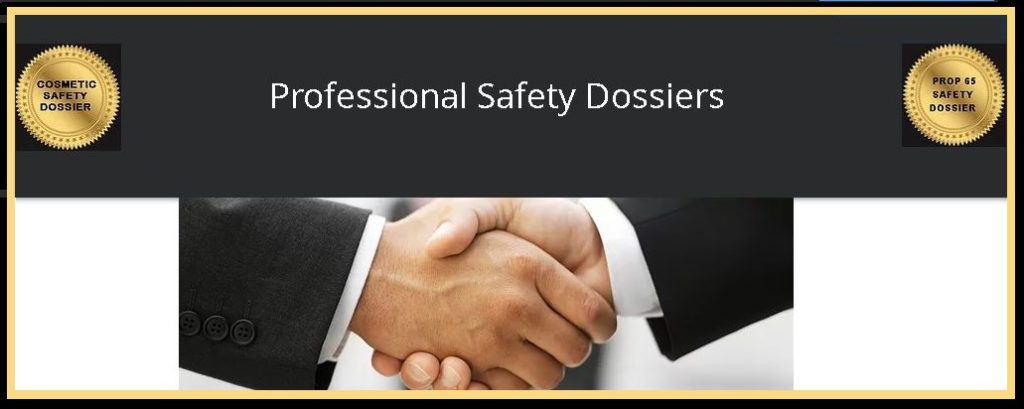Proposition 65: Carcinogenic Chemicals Notification
California Increases Regulation Controls
www.ProfessionalSafetyDossier.com
FEW COMPANIES ARE READY
In 1986 California voters adopted Proposition 65,
“That initiative became the Safe Drinking Water and Toxic Enforcement Act of 1986, better known by its original name of Proposition 65. Proposition 65 requires the State to publish a list of chemicals known to cause cancer or birth defects or other reproductive harm. This list, which must be updated at least once a year, has grown to include approximately 800 chemicals since it was first published in 1987. Proposition 65 requires businesses to notify Californians about significant amounts of chemicals in the products they purchase, in their homes or workplaces, or that are released into the environment.”
Since California is a major part of the US economy, as a practical matter, all businesses selling across state lines find that they must conform to the California law, or provide special California labeling for products shipped or sold in California.
Prop 65 started with a couple hundred chemicals listed. Today the list is over 900 substances. The List of chemicals is here; https://oehha.ca.gov/proposition-65/chemicals.
There are certain limits on the disclosure rule.
“Businesses with less than 10 employees and government agencies are exempt from Proposition 65’s warning requirements … Businesses are also exempt from the warning requirement … if the exposures they cause are so low as to create no significant risk of cancer or birth defects or other reproductive harm…”
“No significant risk” means less than one chance in a 100,000 of causing cancer, or one in 1,000 of causing reproductive harm.
The California government has published “safe harbor” numbers for about 300 substances on the List to guide businesses in determining their responsibilities, here: https://oehha.ca.gov/proposition-65/general-info/current-proposition-65-no-significant-risk-levels-nsrls-maximum.
The question businesses must consider is whether any chemical in the product is in “significant amounts” and must therefore be disclosed by a Notice on the label or if the “exposures” are so low as to “create no significant risk…” and thus no duty to warn.
If the ingredient is one of the named ingredients on the label and it is on the List then, clearly, the Notice is required.
If the substance is a named ingredient, but is only incidentally present, or is used only in process, the question remains: is there a significant amount to disclose?
California reminds businesses:
“Although a business has the burden of proving a warning is not required, a business is discouraged from providing a warning that is not necessary and instead should consider consulting a qualified professional if it believes an exposure to a listed chemical may not require a Proposition 65 warning.”
When a Warning is required, it must be “clear and reasonable” https://oehha.ca.gov/media/downloads/crnr/art6regtextclean090116.pdf
In January 2017 California changed the safe harbor rules for when a Warning is “clear and reasonable”. Additionally, the seriousness of the required warning has increased.
One online source reported:
“The new regulations now require that the safe-harbor warning include the word “WARNING” in all capital letters and bold print and further require that a symbol consisting of a black exclamation point in a yellow equilateral triangle with a bold black outline precede the warning. The new regulations further specify different safe-harbor warnings for products that contain only carcinogens, only reproductive toxicants, both listed carcinogens and listed reproductive toxicants, or a listed chemical that is both a carcinogen and reproductive toxicant.” http://www.klgates.com/warning-proposition-65-warning-requirements-have-changed-01-04-2017/
Here is how a compliant warning will look when the new rules are fully enforced:

Notice that in addition to the yellow warning sign the company must also list the specific ingredients involved. A mere “may contain listed ingredients” warning is no longer sufficient.
In addition to the on the label Warning, the new rules address online warnings:
“To comply with the safe-harbor provisions for Internet purchases, the new regulations require companies to include the safe-harbor warnings on the product display page, in a hyperlink using the word “WARNING” on the product display page, or by otherwise prominently displaying the warning to the purchaser prior to completing the purchase.”
In summary, the new regs will direct consumers to a special P65 government web page. It will be important to make sure that required link opens in a new tab, so the potential customer will not lose the purchase page while looking at the Warning.
Remember, going forward, when you give the required Warning, you must also name the chemical(s) for which the warning is given. You will need accurate tests and a clear Proposition 65 Plan.
The new regulations are fully effective on August 30, 2018 for any product manufactured after that date.
The sooner companies get ready, the better! The Vitamin Consultancy offers Proposition 65 “No Significant Risk” Dossiers to enable compliance with the law, by either complying with the Warning requirement or by having the assurance that the substances pose no significant risk so that the warning is not required. Are you ready?
http://www.professionalsafetydossier.com


